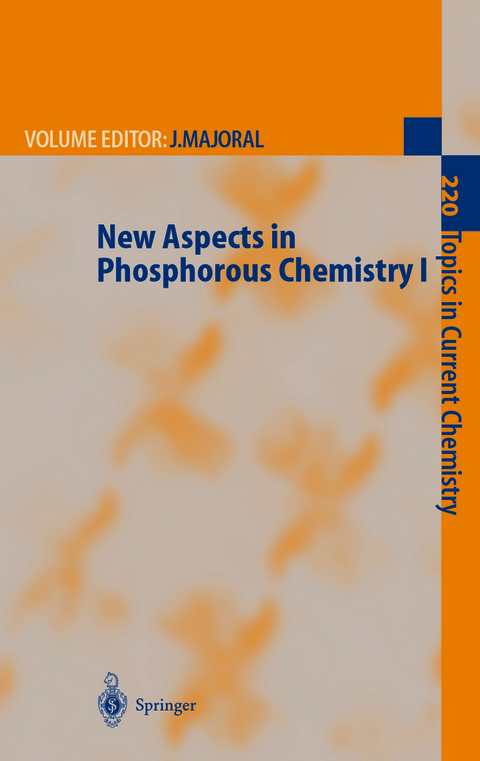
New Aspects in Phosphorus Chemistry I
Seiten
2010
|
1. Softcover reprint of the original 1st ed. 2002
Springer Berlin (Verlag)
978-3-642-07595-7 (ISBN)
Springer Berlin (Verlag)
978-3-642-07595-7 (ISBN)
With contributions by numerous experts
Undoubtedly the chemistry of phosphorus appears more and more attractive in the sense that phosphorus presents an extraordinary versatile behaviour that allows the synthesis of a large number of different phosphorus reagents usable for applications in different fields, from biology to material science without f- getting key applications in catalysis. The full maturity of this topic of research can be explained by all the acquired knowledge over these twenty last years. Organic and inorganic chemistries of P , P and P species have been the s- in ]V v ject of thousands of publications while the chemistry of low coordinated ph- phorus derivatives experienced its hour of glory from the 1970s to the early 1990s. In parallel, interactions between phosphorus compounds and transition metals afforded many complexes, a lot of which present fascinating properties as catalysts. The interest in all these themes really is not decreasing, indeed some fas- nating areas of research are emerging or are the subject of many investigations: the medicinal chemistry of bisphosphonates, the role of phosphorus in biology, phosphorus ligands in radiopharmaceutical chemistry, phosphorus in material science, new polymers and dendrimers incorporating phosphorus, and as- metric catalysis to name but a few. Indeed researchers, benefitting from their background in basic phosphorus chemistry are developing many new fields of research.
Undoubtedly the chemistry of phosphorus appears more and more attractive in the sense that phosphorus presents an extraordinary versatile behaviour that allows the synthesis of a large number of different phosphorus reagents usable for applications in different fields, from biology to material science without f- getting key applications in catalysis. The full maturity of this topic of research can be explained by all the acquired knowledge over these twenty last years. Organic and inorganic chemistries of P , P and P species have been the s- in ]V v ject of thousands of publications while the chemistry of low coordinated ph- phorus derivatives experienced its hour of glory from the 1970s to the early 1990s. In parallel, interactions between phosphorus compounds and transition metals afforded many complexes, a lot of which present fascinating properties as catalysts. The interest in all these themes really is not decreasing, indeed some fas- nating areas of research are emerging or are the subject of many investigations: the medicinal chemistry of bisphosphonates, the role of phosphorus in biology, phosphorus ligands in radiopharmaceutical chemistry, phosphorus in material science, new polymers and dendrimers incorporating phosphorus, and as- metric catalysis to name but a few. Indeed researchers, benefitting from their background in basic phosphorus chemistry are developing many new fields of research.
Diphosphorus-Containing Unsaturated Three-Membered Rings: Comparison of Carbon, Nitrogen, and Phosphorus Chemistry.- New Trends in Phosphametallocene Chemistry.- Benzyne-Zirconocene Reagents as Tools in Phosphorus Chemistry.- New Chiral Organophosphorus Catalysts in Asymmetric Synthesis.- Metal-Mediated Degradation and Reaggregation of White Phosphorus.- New Inorganic Polymers Containing Phosphorus.- Recent Advances in Stereocontrolled Synthesis of P-Chiral Analogues of Biophosphates.- Recent Progress in Carbonylphosphonate Chemistry.
| Erscheint lt. Verlag | 1.12.2010 |
|---|---|
| Reihe/Serie | Topics in Current Chemistry |
| Zusatzinfo | X, 244 p. |
| Verlagsort | Berlin |
| Sprache | englisch |
| Maße | 155 x 235 mm |
| Gewicht | 389 g |
| Themenwelt | Naturwissenschaften ► Chemie ► Anorganische Chemie |
| Naturwissenschaften ► Chemie ► Organische Chemie | |
| Technik ► Maschinenbau | |
| Schlagworte | Anorganic Chemistry • Anorganische Chemie • Chemistry • Compound • Organic Chemistry • Organische Chemie • Polymer • Polymere • Polymers |
| ISBN-10 | 3-642-07595-9 / 3642075959 |
| ISBN-13 | 978-3-642-07595-7 / 9783642075957 |
| Zustand | Neuware |
| Haben Sie eine Frage zum Produkt? |
Mehr entdecken
aus dem Bereich
aus dem Bereich


